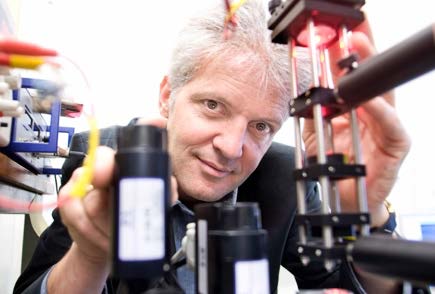Lecture 2
DNA loop extrusion by the SMC molecular motors that organize our chromosomes
| Speaker | Distinguished Prof Cees Dekker, Kavli Institute of Nanoscience, Delft University of Technology, The Netherlands |
| Date/Time | Thursday, 7 Nov, 10AM |
| Location | Lecture Theatre 32 |
| Moderator | A/Prof Wang Zhisong |
Abstract
Structural Maintenance of Chromosomes (SMC) proteins like cohesin and condensin spatially organize chromosomes by extruding DNA into large loops. We discovered many of the intriguing properties of this new class of DNA-translocating molecular motors by directly visualizing the processive extension of DNA loops by SMCs in real-time [1]. Single-molecule methodologies have since then provided many new insights into the structure and function of this novel class of DNA-processing molecular motors [2]. Strikingly, SMCs can easily bypass DNA-binding proteins on DNA, even ones that exceed the size of the large ring-shaped SMCs – demonstrating that loop extrusion occurs nontopologically. Due to biochemical interactions, however, the DNA-binding protein CTCF can stop SMC traversal, which makes it define topologically associating domains in chromosomes.
In my presentation, I will present the most exciting latest experiments from our lab. Magnetic tweezers resolved the force-dependent step size and identified ATP binding as the step-generating process in DNA loop extrusion by condensin [3]. Surprisingly, we recently found that all SMCs induce 0.6 negative supercoil into the extruded loop in each individual step of the loop extrusion [4]. These findings have direct implications for modelling these intriguing floppy molecular motors. Using a single-molecule visualization assay, we extensively studied how SMC proteins interact with DNA-binding proteins that potentially act as roadblocks to loop extrusion. Strikingly, we found that SMCs can easily bypass most proteins roadblocks on DNA [5], even ones that exceed the size of the large ring-shaped SMCs – demonstrating that loop extrusion occurs nontopologically (i.e., without DNA passing through the lumen of the SMC). Due to biochemical interactions, however, the DNA-binding protein CTCF (which is the key element defining topologically associating domains in chromosomes) was found to asymmetrically block loop-extruding cohesin, in a process which was found to be dependent on DNA tension. The data show that CTCF is not, as previously assumed, simply a barrier to cohesin-mediated loop extrusion but an active regulator of this process. Finally, we have discovered that the cohesin subunit NIPBL is a direction switch for the cohesin which is a 1-side DNA loop extruder [7].
Overall the results reveal mechanistic principles of how SMCs regulate the genome architecture.
References:
[1] Ganji et al, Science 360, 102 (2018)
[2] Kim et al, Nature 579, 438 (2020); C. Dekker et al, Science (under review)
[3] Ryu et al, Nucl. Acid Res. 50, 820 2022)
[4] Janissen et al, Nucl. Acid Res., under review
[5] B. Pradhan et al, Cell Reports 41, 111491(2022)
[6] Davidson et al, Nature 616, 822 (2023)
[7] Barth et al, under review (2024)

Biography
Cees Dekker is a physicist who moved from quantum solid-state physics to nanobiology. In the 1990s, he pioneered nanotechnology and discovered many of the exciting electronic properties of carbon nanotubes, establishing the first single-molecule transistor. In 2000, he moved to single-molecule biophysics and nanobiology, applying nanotechnology to biological systems and enforcing various breakthroughs from DNA and protein sequencing with nanopores to DNA loop extrusion by novel motor proteins. His current research focuses on nanopores, chromosome structure, and developing synthetic cells. Characteristically, Dekker pioneers new fields and defines new directions, both organizationally in e.g. establishing the Kavli Institute and a new Department of Bionanoscience at Delft and spearheading international initiatives to build synthetic cells, but more importantly also scientifically – by pioneering molecular electronics and nanobiology yielding major discoveries from nanopore sequencing to DNA loop extrusion by motor proteins.
Read more: http://ceesdekkerlab.nl
